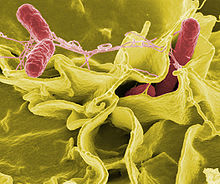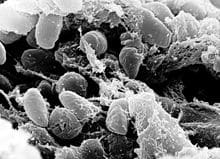Which bacterium is your favorite in this matchup?
Salmonella typhimurium (left image) is one of the main causes of food poisoning, and, in rare cases, can cause death by extreme loss of electrolytes and fluids. Cooking and pasteurization generally kill this bacterium, so undercooked eggs and meat as well as unpasteurized cheese, milk, or juice are all possible contamination sources. Between 0.6% and 3% of egg yolks contain the bacterium. On Earth, Salmonella poisoning is already pretty bad. But in space it really would cause some trouble, as it becomes more virulent at zero-gravity. In an experiment conducted by NASA, it was found that S. typhimurium was three times more virulent in space. For most of us, this phenomenon will not present itself as an issue, but astronauts: beware of (even delicious) unpasteurized cheeses.
Friendly or Deadly: Most deaths occur among people who already have compromised immune systems. For the 1,400,000 cases of salmonella in the US each year, the fatality rate is less than 1%.
Yersinia pestis (right image) is the bacterium responsible for the Black Death, also known as the Bubonic Plague, which killed one third of the European population during the 14th century. Even in the modern age, between 1,000 and 2,000 of cases of plague are reported globally. In the US alone, between 1-17 cases appear every year. However, the prognosis is much better for those infected today than it was for the millions of people who suffered in the Middle Ages. The symptoms exhibited by those infected by Y. pestis range from nausea and fatigue to blackening and death of tissue. Plague is often carried by rodents or fleas, or transmitted from human to human from coughing and sneezing. Luckily, it is now treatable with antibiotics.
Friendly or Deadly: Deadly! Death can occur in less than 2 weeks for some. Globally, mortality rates hover between 8-10%. Without any intervention, the death rate is 100%

